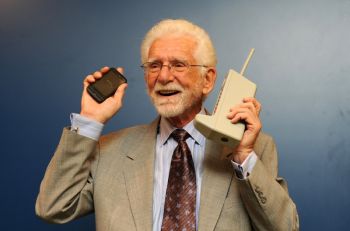Dinosaur Peptides Suggest Mechanisms of Protein Survival
IIT’s Joseph Orgel Part of Team Offering New Information about Tissue in Fossilized Dinosaur Bones
New findings about surviving collagen found in fossilized bones of two dinosaurs may help us to better understand collagen’s structure and function, and promise more effective use of collagen in human medical applications treating conditions such as heart disease and arthritis.
A team of researchers, led by Illinois Institute of Technology Assistant Professor of Biology Joseph Orgel, mapped collagen peptide sequences recovered from the chemical extracts of dinosaur bones onto molecular models of human and rat collagen. Comparing them, researchers found that only certain parts of a collagen sequence were preserved in the dinosaur bones, providing new information about which parts of the molecule are most durable and thus useful in such applications as tendon and bone regeneration, and offering new clues for such things as molecular-based disease processes.
Their findings are published in the June 6 PloS ONE, http://journals.plos.org/plosone/article?id=10.1371/journal.pone.0020381#authcontrib
In 2004, Professor Mary Schweitzer of North Carolina State University and colleagues discovered pieces of collagen in bones from two different dinosaurs that had lived millions of years apart from each other.
Orgel and James D. San Antonio of Orthovito, who have studded the structure and function of collagen for more than 10 years, approached Schweitzer and several other researchers to help them answer a new question: did the collagen pieces that survived in the fossils arise randomly from all over the collagen molecule, or represent only certain parts of collagen that survived preferentially, according to their location and function?
Together, the researchers learned:
- Only certain parts of the collagen molecule survived in the fossils, and in several cases, the parts that survived were the same in fossils from both species of dinosaurs.
- The parts of collagen that survived tended to be those which (their collagen models tell them) are most sheltered or protected in the center of the collagen molecule, and which also carry out crucial biologic functions such as interaction between collagen and cells.
- All of the pieces of collagen that survived also had a distinct chemical nature- they were less negatively charged than other parts of the collagen molecule. Their lower charge may make them more resistant to enzymes and hydration, and thus more resistant to decomposition in the fossil bone.
Orgel and San Antonio have worked to build molecular models of type I collagen, the most abundant protein in humans and all vertebrates, for 10 years. The goal of the work is to understand the structure and function of the complex molecule.
The researchers have made significant strides in understanding what the molecule looks like in three dimensions- like a massive, multi-stranded rope (Orgel's group), and how it interacts with cell and other molecules (San Antonio's group) and later to form the crucial scaffold for many tissues in the body, like bone and skin (San Antonio and Orgel). The collagen molecule is also very stable, with a massive rope-like structure that is tougher than steel on a gram for gram basis, resistant to breakdown by most enzymes, and has many intermolecular cross-links that stiffen it and join the individual collagen “ropes” together.
In their research with Schweitzer, Orgel and San Antonio both confirmed aspects of their collagen models and extended their understanding of how the molecules can now be used.
“First, the data we obtained is consistent with, and validates the findings from our collagen modeling projects,” said Orgel. “Second, understanding which parts of collagen are the most durable over time and in challenging environments may help us design longer lasting, more effective collagen for use in human medical applications, such as in designing collagen-based medical implants and medical formulations.”
Identifying the elements of the collagen fibril most resistant to degradation in fossils may lead to the rational design of collagenous scaffolds with enhanced in vivo longevities to support tendon or bone regeneration in humans. Similarly, identifying naturally occurring modifications on these molecules that contribute to preservation may also shed light on molecular-based disease processes.
Researchers showed that molecular preservation is linked to protein function, and discussed how sequences of ancient peptides can test models of molecular function in extant organisms. In addition, they showed how models of extant protein function suggest a mechanism for the survival of proteins in exceptionally well preserved fossils.
Founded in 1890, IIT is a Ph.D.-granting university with more than 7,700 students in engineering, sciences, architecture, psychology, design, humanities, business and law. IIT's interprofessional, technology-focused curriculum is designed to advance knowledge through research and scholarship, to cultivate invention improving the human condition, and to prepare students from throughout the world for a life of professional achievement, service to society, and individual fulfillment. Visit www.iit.edu.




